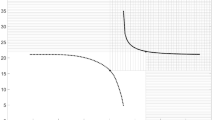Abstract
The benchmarking problem arises when time series data for the same target variable are measured at different frequencies with different level of accuracy, and there is the need to remove discrepancies between annual benchmarks and corresponding sums of the sub-annual values. Two widely used benchmarking procedures are the modified Denton Proportionate First Differences (PFD) and the Causey and Trager Growth Rates Preservation (GRP) techniques. In the literature it is often claimed that the PFD procedure produces results very close to those obtained through the GRP procedure. In this chapter we study the conditions under which this result holds, by looking at an artificial and a real-life economic series, and by means of a simulation exercise.
The views expressed herein are those of the authors and should not be attributed to the IMF, its Executive Board, or its management
Access this chapter
Tax calculation will be finalised at checkout
Purchases are for personal use only
Similar content being viewed by others
Notes
- 1.
- 2.
For a recent survey on this issue, see Di Fonzo and Marini [8].
- 3.
The median is more representative than the mean in the case of atypical values. We also calculated mean, standard deviation, minimum, and range of r 1 and r 2, available on request from the authors.
- 4.
When the preliminary series were used as starting values, in 50 out of 25,000 cases (0.2%) the GRP procedure produced benchmarked series with r 2 > 1.
- 5.
The index r 1 is greater than one for 488 out of 25,000 series (1,95%). The highest number of cases with r 1 > 1 (270) is observed for (σ e , μ) = (5, 0), followed by 101 cases for (σ e , μ) = (10, 0). The remaining cases are: 50 for (σ e , μ) = (15, 0), 15 for (σ e , μ) = (20, 0), 4 for (σ e , μ) = (25, 0), 20 for (σ e , μ) = (5, 15), 15 for (σ e , μ) = (10, 15), 8 for (σ e , μ) = (15, 15), 2 for (σ e , μ) = (20, 15), and 3 for (σ e , μ) = (25, 15).
References
Bloem, A., Dippelsman, R., Mæhle, N.: Quarterly National Accounts Manual. Concepts, Data Sources, and Compilation. International Monetary Fund, Washington D.C. (2001)
Bozik, J.E., Otto, M.C.: Benchmarking: Evaluating methods that preserve month-to-month changes. Bureau of the Census - Statistical Research Division, RR-88/07 (1988) http://www.census.gov/srd/papers/pdf/rr88-07.pdf
Causey, B., Trager, M.L.: Derivation of Solution to the Benchmarking Problem: Trend Revision. Unpublished research notes, U.S. Census Bureau, Washington D.C. (1981). Available as an appendix in Bozik and Otto (1988)
Cholette, P.A.: Adjusting sub-annual series to yearly benchmarks. Surv. Meth. 10, 35–49 (1984)
Dagum, E.B., Cholette, P.A.: Benchmarking, Temporal Distribution, and Reconciliation Methods for Time Series. Springer, New York (2006)
Denton, F.T.: Adjustment of monthly or quarterly series to annual totals: An approach based on quadratic minimization. JASA 333, 99–102 (1971)
Di Fonzo, T., Marini, M.: Simultaneous and two-step reconciliation of systems of time series: methodological and practical issues. JRSS C (Appl. Stat.) 60, 143–164 (2011a)
Di Fonzo, T., Marini, M.: A Newton’s Method for Benchmarking Time Series According to a Growth Rates Preservation Principle. Department of Statistical Sciences, University of Padua, Working Paper Series 17 (2011b). http://www.stat.unipd.it/ricerca/fulltext?wp=432
Luenberger, D.G.: Linear and Nonlinear Programming. Addison-Wesley, Reading (1984)
Titova, N, Findley, D., Monsell, B.C.: Comparing the Causey-Trager method to the multiplicative Cholette-Dagum regression-based method of benchmarking sub-annual data to annual benchmarks. In: JSM Proceedings, Business and Economic Statistics Section. American Statistical Association, Alexandria, VA (2010)
Trager, M.L.: Derivation of Solution to the Benchmarking Problem: Relative Revision. Unpublished research notes, U.S. Census Bureau, Washington D.C. (1982) Available as an appendix in Bozik and Otto (1988)
U.S. Census Bureau: X-12-ARIMA Reference manual, Version 0.3. U.S. Census Bureau, U.S. Department of Commerce, Washington D.C. (2009). http://www.census.gov/srd/www/x12a/
Author information
Authors and Affiliations
Corresponding author
Editor information
Editors and Affiliations
Appendix: Non-singularity of the Coefficient Matrix of System (45.2)
Appendix: Non-singularity of the Coefficient Matrix of System (45.2)
Luenberger [9, p. 424] shows that a unique solution to the problem
exists if the matrix C is of full rank, and the matrix Q is positive definite on the null space of matrix C: \(\mathcal{N}(\mathbf{C}) =\{ \mathbf{x} \in {\mathbb{R}}^{n} : \mathbf{Cx} = \mathbf{0}\}\).
Let us consider the matrix \(\mathbf{Q} ={ \mathbf{P}}^{-1}\boldsymbol{\Delta }^{\prime}_{n}\boldsymbol{\Delta }_{n}{\mathbf{P}}^{-1}\), and let the vector y belong to \(\mathcal{N}\)(C). We assume p t ≠0, t = 1, …, n (otherwise the objective function is not defined), and Cp≠Y, which corresponds to exclude the trivial solution y ∗ = p, valid when there is no benchmarking problem. Given that
it is immediately recognized that the expression above is strictly positive, which means that matrix \(\mathbf{Q} ={ \mathbf{P}}^{-1}\boldsymbol{\Delta }^{\prime}_{n}\boldsymbol{\Delta }_{n}{\mathbf{P}}^{-1}\) is positive definite on the null space spanned by the columns of matrix C, and thus the coefficient matrix of system (45.2) is nonsingular.
Rights and permissions
Copyright information
© 2013 Springer-Verlag Berlin Heidelberg
About this chapter
Cite this chapter
Fonzo, T.D., Marini, M. (2013). Benchmarking and Movement Preservation: Evidences from Real-Life and Simulated Series. In: Torelli, N., Pesarin, F., Bar-Hen, A. (eds) Advances in Theoretical and Applied Statistics. Studies in Theoretical and Applied Statistics(). Springer, Berlin, Heidelberg. https://doi.org/10.1007/978-3-642-35588-2_45
Download citation
DOI: https://doi.org/10.1007/978-3-642-35588-2_45
Published:
Publisher Name: Springer, Berlin, Heidelberg
Print ISBN: 978-3-642-35587-5
Online ISBN: 978-3-642-35588-2
eBook Packages: Mathematics and StatisticsMathematics and Statistics (R0)




